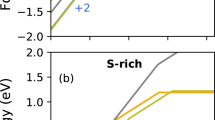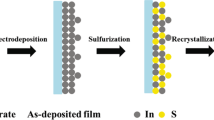Abstract
Herein, we report a theoretical investigation based on DFT calculations devoted to the nature of charge carriers in the β-In2S3 material used as buffer in chalcopyrite thin-film solar cells. Our simulations led to unambiguous results concerning the incapability for this material to be a p-type semiconductor. Furthermore, it is demonstrated that the insertion of indium into a Td interstitial site seems to be the driving force leading to a natural n-type conductivity. Our calculations took into account different atmospheres in order to be directly comparable with experimental data. In particular, the competitive InS structure was considered. It is shown that the S-poor condition strongly lesser the defect formation energy and should be privileged to achieve high free electron concentrations for potential applications.






Similar content being viewed by others
References
Naghavi N, Abou-Ras D, Allsop N et al (2010) Buffer layers and transparent conducting oxides for chalcopyrite Cu(In, Ga)(S, Se)2 based thin film photovoltaics: present status and current developments. Prog Photovolt Res Appl 18:411–433. https://doi.org/10.1002/pip.955
Barreau N (2009) Indium sulfide and relatives in the world of photovoltaics. Sol Energy 83:363–371. https://doi.org/10.1016/j.solener.2008.08.008
Pistor P, Merino Álvarez JM, León M et al (2016) Structure reinvestigation of α-, β- and γ-In 2 S 3. Acta Crystallogr Sect B Str Sci Cryst Eng Mater 72:410–415. https://doi.org/10.1107/s2052520616007058
Seyam AAES and DAE and HSM and MAM (1998) Electrical properties of beta-In2S3 thin films. J Phys: Condens Matter 10:5943
Péan EV, Barreau N, Vidal J et al (2017) Theoretical investigation of CdIn2S4: a possible substitute for CdS in CuIn1–xGaxSe2-based photovoltaic devices. Phys Rev Mater 1:64605. https://doi.org/10.1103/physrevmaterials.1.064605
Perdew JP, Burke K, Ernzerhof M (1996) Generalized gradient approximation made simple. Phys Rev Lett 77:3865–3868. https://doi.org/10.1103/physrevlett.77.3865
Kresse G, Furthmüller J (1996) Efficient iterative schemes for ab initio total-energy calculations using a plane-wave basis set. Phys Rev B 54:11169–11186. https://doi.org/10.1103/physrevb.54.11169
Kresse G, Furthmüller J (1996) Efficiency of ab initio total energy calculations for metals and semiconductors using a plane-wave basis set. Comput Mater Sci 6:15–50. https://doi.org/10.1016/0927-0256(96)00008-0
Kresse G, Joubert D (1999) From ultrasoft pseudopotentials to the projector augmented-wave method. Phys Rev B 59:1758–1775. https://doi.org/10.1103/physrevb.59.1758
Rinke P, Janotti A, Scheffler M, Van de Walle CG (2009) Defect formation energies without the band-gap problem: combining density-functional theory and the GW approach for the silicon self-interstitial. Phys Rev Lett 102:26402. https://doi.org/10.1103/physrevlett.102.026402
Péan E, Vidal J, Jobic S, Latouche C (2017) Presentation of the PyDEF post-treatment python software to compute publishable charts for defect energy formation. Chem Phys Lett 671:124–130. https://doi.org/10.1016/j.cplett.2017.01.001
Stevanović V, Lany S, Zhang X, Zunger A (2012) Correcting density functional theory for accurate predictions of compound enthalpies of formation: fitted elemental-phase reference energies. Phys Rev B 85:115104. https://doi.org/10.1103/physrevb.85.115104
Lany S, Zunger A (2009) Accurate prediction of defect properties in density functional supercell calculations. Model Simul Mater Sci Eng 17:84002. https://doi.org/10.1088/0965-0393/17/8/084002
Kumagai Y, Oba F (2014) Electrostatics-based finite-size corrections for first-principles point defect calculations. Phys Rev B 89:195205. https://doi.org/10.1103/physrevb.89.195205
Beaujuge PM, Fréchet JMJ (2011) Molecular design and ordering effects in π-functional materials for transistor and solar cell applications. J Am Chem Soc 133:20009–20029
Heyd J, Scuseria GE (2004) Efficient hybrid density functional calculations in solids: assessment of the Heyd–Scuseria–Ernzerhof screened coulomb hybrid functional. J Chem Phys 121:1187–1192
Tao W, Qing G, Yan L, Kuang S (2012) A comparative investigation of an AB-and AA-stacked bilayer graphene sheet under an applied electric field: a density functional theory study. Chin Phys B 21:67301
Karlický F, Zbořil R, Otyepka M (2012) Band gaps and structural properties of graphene halides and their derivates: a hybrid functional study with localized orbital basis sets. J Chem Phys 137:34709
Dai J, Zeng XC (2014) Bilayer phosphorene: effect of stacking order on bandgap and its potential applications in thin-film solar cells. J Phys Chem Lett 5:1289–1293
Kharche N, Nayak SK (2011) Quasiparticle band gap engineering of graphene and graphone on hexagonal boron nitride substrate. Nano Lett 11:5274–5278
Azpiroz JM, Ugalde JM, Infante I (2014) Benchmark assessment of density functional methods on group II–VI MX (M = Zn, Cd; X = S, Se, Te) quantum dots. J Chem Theory Comput 10:76–89
Kay A, Cesar I, Grätzel M (2006) New benchmark for water photooxidation by nanostructured α-Fe2O3 films. J Am Chem Soc 128:15714–15721
Takei K, Chuang S, Fang H et al (2011) Benchmarking the performance of ultrathin body InAs-on-insulator transistors as a function of body thickness. Appl Phys Lett 99:103507
Heyd J, Peralta JE, Scuseria GE, Martin RL (2005) Energy band gaps and lattice parameters evaluated with the Heyd-Scuseria-Ernzerhof screened hybrid functional. J Chem Phys 123:174101
Alkauskas A, Pasquarello A (2011) Band-edge problem in the theoretical determination of defect energy levels: the O vacancy in ZnO as a benchmark case. Phys Rev B 84:125206
Liao P, Carter EA (2011) Testing variations of the GW approximation on strongly correlated transition metal oxides: hematite (α-Fe2O3) as a benchmark. Phys Chem Chem Phys 13:15189–15199
Tongay S, Zhou J, Ataca C et al (2012) Thermally driven crossover from indirect toward direct bandgap in 2D semiconductors: MoSe2 versus MoS2. Nano Lett 12:5576–5580
García-Fernández P, Ghosh S, English NJ, Aramburu JA (2012) Benchmark study for the application of density functional theory to the prediction of octahedral tilting in perovskites. Phys Rev B 86:144107
Song J-W, Yamashita K, Hirao K (2011) Communication: a new hybrid exchange correlation functional for band-gap calculations using a short-range Gaussian attenuation (Gaussian-Perdue–Burke–Ernzerhof). J Chem Phys 135:71103
Grimme S (2006) Semiempirical GGA-type density functional constructed with a long-range dispersion correction. J Comput Chem 27:1787–1799
Bruneval F, Marques MAL (2012) Benchmarking the starting points of the GW approximation for molecules. J Chem Theory Comput 9:324–329
Lany S, Zunger A (2008) Assessment of correction methods for the band-gap problem and for finite-size effects in supercell defect calculations: case studies for ZnO and GaAs. Phys Rev B 78:235104. https://doi.org/10.1103/physrevb.78.235104
Freysoldt C, Neugebauer J, Van de Walle CG (2009) Fully Ab initio finite-size corrections for charged-defect supercell calculations. Phys Rev Lett 102:16402. https://doi.org/10.1103/physrevlett.102.016402
Komsa H-P, Rantala TT, Pasquarello A (2012) Finite-size supercell correction schemes for charged defect calculations. Phys Rev B 86:45112. https://doi.org/10.1103/physrevb.86.045112
Radautsan SI, Syrbu NN, Tezlevan VE et al (1973) Optical and photoelectrical properties and band structure of single crystals of solid solutions of the system (CdS)3x–(In2S3)1 − x. Phys Status Solidi 15:295–302. https://doi.org/10.1002/pssa.2210150133
Watkins GD Negative-U properties for defects in solids. In: Adv. Solid State Phys. Springer Berlin pp 163–189
Zunger A (2003) Practical doping principles. Appl Phys Lett 83:57–59. https://doi.org/10.1063/1.1584074
Quéré Y (1988) Physique des matériaux: cours et problèmes. Ellipses, Paris
Sze SM, Kwok NK (2006) Physics of semiconductor devices, 3rd Edition, Wiley. doi: http://eu.wiley.com/WileyCDA/WileyTitle/productCd-0471143235.html
Hummel RE (2011) Electronic properties of materials. https://doi.org/10.1007/978-1-4419-8164-6
Ghorbani E, Albe K (2018) Intrinsic point defects in β-In2S3 studied by means of hybrid density-functional theory. J Appl Phys 123:103103. https://doi.org/10.1063/1.5020376
Acknowledgement
This research used resources of CCIPL (Centre de Calcul Intensif des Pays de Loire). The authors greatly acknowledge ARZEL Ludovic, CALDES Maite, GUILLOT-DEUDON Catherine, HAREL Sylvie, LAFOND Alain and VIDAL Julien for fruitful discussions. A.S. thanks the CNRS and Région Pays de la Loire for their financial support.
Author information
Authors and Affiliations
Corresponding author
Additional information
Published as part of the special collection of articles “CHITEL 2017 - Paris - France”.
Rights and permissions
About this article
Cite this article
Stoliaroff, A., Barreau, N., Jobic, S. et al. β-In2S3 for photovoltaic devices: investigation of the native point defects with ab initio first-principle calculations. Theor Chem Acc 137, 102 (2018). https://doi.org/10.1007/s00214-018-2273-5
Received:
Accepted:
Published:
DOI: https://doi.org/10.1007/s00214-018-2273-5




